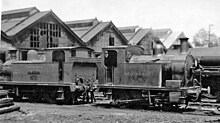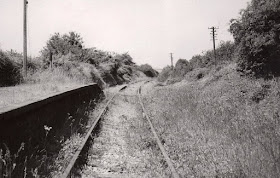1121 Eastleigh 13.5.1973
1127 Eastleigh 13.5.1973
1129 Eastleigh 13.5.1973
1121 (ex Fareham) Eastleigh 13.5.1973
Back in May 1973 I was just sixteen and armed with the ubiquitous Zenith Russian-made camera that most of us had (and a few frames of film) I made my way over to Eastleigh for the Works Open Day. This was never really my thing, I've always been far more interested in the lines themselves rather than what ran over them, but it was fun to get close to stuff for a change! Back then I was still sulking that I'd just missed real steam (which had ended less than 6 years at Eastleigh) so the presence of a steam loco caught my interest.
The few random shots of the station ooze atmosphere now, being 42 years old! For some reason I only seem to have taken pics of rail blue Thumpers, but having been brought up slap bang in the middle of Southern Electric territory diesels in any form were VERY exotic, which probably expalins it!
At Eastleigh there was an interesting combination that was working the shuttle into the works itself - Class 33 6535 and 4-TC 418.
6535 Eastleigh (Works Open Day shuttle) 13.5.1973
4-TC 418 Eastleigh (Works Open Day shuttle) 13.5.1973
6535 propels 418 Eastleigh Works Open Day shuttle 13.5.1973
It was a quick trip into the Works! (The Ford Anglia wasn't one of the displays by the way!)
6535 Eastleigh Works Open Day 13.5.1973
Over at the works I was able to roam around and get a few more pics on my rapidly filling roll of film - with a glimpse at the past and the space age vision of loveliness below -
4001 Eastleigh Works Open Day 13.5.1973
4001 Eastleigh Works Open Day 13.5.1973
Also on display was this nice pre-TOPS class 73 and School Class 'Stowe'.
E6012 Eastleigh Works Open Day 13.5.1973
928 Stowe Eastleigh Works Open Day 13.5.1973
Back to Littlehampton via Fareham, Fratton and Barnham and a last look at the event ...
Eastleigh Works Open Day 13.5.1973
Eastleigh Works is a locomotive, carriage and wagon building and repair facility in the town of
Eastleigh in the county of
Hampshire in England.
History

Eastleigh Works Management Building
LSWR
Among the locomotives produced by the LSWR under Drummond at Eastleigh were the
S14 0-4-0 and
M7 0-4-4 tank engines, the
P14 and
T14 4-6-0, and
D15 4-4-0, classes. Following the appointment of
Robert Urie as Chief Mechanical Engineer in 1912, the works were responsible for the construction of the
H15,
S15, and
N15 (King Arthur)
4-6-0 classes, and the
G16 4-8-0, and
H16 4-6-0 tank engines.
Southern Railway

The old canteen shown from inside the works November 2014
Following the merger of the LSWR and other railways in southern England to form the
Southern Railway, as part of the
Railways Act grouping of 1923, Eastleigh was to become the principal works for the new railway. The new Chief Mechanical Engineer,
Richard Maunsell re-organised the works and directed the design and construction of various new classes.
Like most of the railway works, Eastleigh was heavily involved in the war effort, producing, in 1938, sets of parts to convert
Blenheim bombers so that they could be used as fighters. The works was also part of a joint venture with other workshops, railway and private, to produce
Horsa gliders for the
D-Day airborne assault. With
Lancing works, it turned out 200 tail units. It also produced 1,500 anti-tank gun barrels and, with
Brighton railway works, 240 multiple rocket launchers, plus landing craft, fuel tenders and harbour launches.
In 1945, the carriage works began constructing all-steel carriages, both electric and steam hauled. It pioneered the use of plastics and glass fibre reinforced resin for doors, seating and roof sections.

B4 0-4-0T 30102 at Eastleigh 1964
British Rail
In 1950, following the nationalisation of the Southern Railway to form the
Southern Region of British Railways new steam locomotive building ceased at Eastleigh. However the works were kept fully occupied between 1956 and 1961 in rebuilding over 90 of the Bulleid 4-6-2 classes. Thereafter the works gradually changed over to steam and diesel repairs.
In 1962, the works was again reorganised with the carriage works site being sold, and carriage and
electric multiple unit repairs transferred to the main locomotive works.
Post privatisation

A circular view from a central part of the sheds in November 2014.
The plant was acquired from
BREL through a management buyout becoming
Wessex Traincare Ltd; it was acquired by
Alstom and renamed
Alstom Wessex Traincare. The site was used for carriage and multiple unit repairs. In 2004 the company announced it was to close the works due to lack of work, work at the site continued until March 2006.
The 42-acre (17 ha) site has been managed since 2002 by
St. Modwen Properties in 2007
Knights Rail Services (KRS) began operations on site, using it to store off lease rolling stock, as well as undertake repairs and refurbishments. As of 2010, the site's facilities include overhead cranes, third rail electricity supply, paint facility, and refuelling facility. Additionally
Siemens undertook maintenance of
Class 444 and
Class 450 on site, and Network Rail
MPVs were stored on site. Arlington Fleet Services Ltd. (maintenance, heavy repair, painting) performs maintenance from the site.
In 2012 KRS acquired an extended lease on the site to 2016.
Locomotive Depot

Eastleigh Locomotive Depot showing ex-Plymouth, Devonport & SW Junction 0-6-0T No. 756 'A.S. Harris' and C14 class 0-4-0T No. 3744 11 July 1946.
Adjacent to the locomotive works was a very large 15-road engine shed which was opened in 1903 and closed in 1967.
[10] This depot was one of the largest on the SR: in 1946 its allocation was 131 engines of extraordinary variety in age and origin:- 17 4-6-0, 31 4-4-0, 7 2-6-0, 19 0-6-0, 15 0-4-2, 1 0-8-0T, 13 0-6-0T, 23 0-4-4T and 5 0-4-0T. Although closed as a TMD, the site was used for scrapping engines as late as 2003.

































